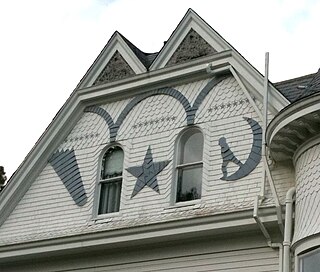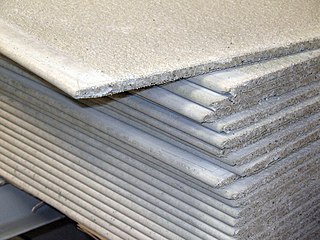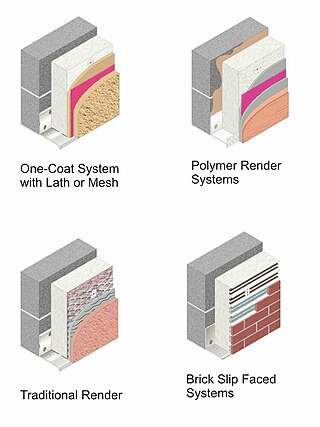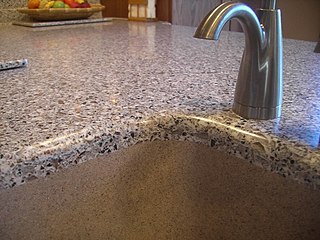
A thermoplastic, or thermosoftening plastic, is any plastic polymer material that becomes pliable or moldable at a certain elevated temperature and solidifies upon cooling.
Flooring is the general term for a permanent covering of a floor, or for the work of installing such a floor covering. Floor covering is a term to generically describe any finish material applied over a floor structure to provide a walking surface. Both terms are used interchangeably but floor covering refers more to loose-laid materials.

A structural insulated panel, or structural insulating panel, (SIP), is a form of sandwich panel used in the construction industry.

Siding or wall cladding is the protective material attached to the exterior side of a wall of a house or other building. Along with the roof, it forms the first line of defense against the elements, most importantly sun, rain/snow, heat and cold, thus creating a stable, more comfortable environment on the interior side. The siding material and style also can enhance or detract from the building's beauty. There is a wide and expanding variety of materials to side with, both natural and artificial, each with its own benefits and drawbacks. Masonry walls as such do not require siding, but any wall can be sided. Walls that are internally framed, whether with wood, or steel I-beams, however, must always be sided.

Polyvinyl fluoride (PVF) or –(CH2CHF)n– is considered to be a thermoplastic fluoropolymer, but it cannot be processed conventionally, as it is unstable above its melting point. Its structure is very similar to that of polyvinyl chloride (PVC) and is made of repeating vinyl fluoride units.

Vinyl composition tile (VCT) is a finished flooring material used primarily in commercial and institutional applications. Modern vinyl floor tiles and sheet flooring and versions of those products sold since the early 1980s are composed of colored polyvinyl chloride (PVC) chips formed into solid sheets of varying thicknesses by heat and pressure. Floor tiles are cut into modular shapes such 12-by-12-inch squares or 12-by-24-inch rectangles. In installation the floor tiles or sheet flooring are applied to a smooth, leveled sub-floor using a specially formulated vinyl adhesive or tile mastic that remains pliable. In commercial applications some tiles are typically waxed and buffed using special materials and equipment.

Fiber cement siding is a building material used to cover the exterior of a building in both commercial and domestic applications. Fiber cement is a composite material made of cement reinforced with cellulose fibers. Originally, asbestos was used as the reinforcing material but, due to safety concerns, that was replaced by cellulose in the 1980s. Fiber cement board may come pre-painted or pre-stained or can be done so after its installation.
Vinyl coated polyester is a material frequently used for flexible fabric structures. It is made up of a polyester scrim, a bonding or adhesive agent, and an exterior PVC coating. The scrim supports the coating and provides the tensile strength, elongation, tear strength, and dimensional stability of the resulting fabric. Depending on its formula, the PVC coating makes the material waterproof and resistant to dirt, mildew, oil, salt, chemicals and UV rays and gives the material added strength and durability. It can be sewn or heat sealed by way of RF(Radio Frequency) welding or hot-air welding.

A cement board is a combination of cement and reinforcing fibers formed into sheets, of varying thickness that are typically used as a tile backing board. Cement board can be nailed or screwed to wood or steel studs to create a substrate for vertical tile and attached horizontally to plywood for tile floors, kitchen counters and backsplashes. It can be used on the exterior of buildings as a base for exterior plaster (stucco) systems and sometimes as the finish system itself.

An external wall insulation system is a thermally insulated, protective, and decorative exterior cladding procedure involving the use of expanded polystyrene, mineral wool, polyurethane foam or phenolic foam, topped off with a reinforced cement based, mineral or synthetic finish and plaster.
Insulated siding is home siding that includes rigid foam insulation, fused behind the exterior surface of the wall, for the purpose of reducing energy consumption, increasing the insulation value of the wall system and improving the stability and appearance of the siding. Currently, insulated siding is commercially available as a type of vinyl siding.
A fabric structure is a structure made of fabric, with or without a structural frame made from the weaving of the fabric itself. The technology provides end users a variety of aesthetic free-form building designs. Custom-made structures are engineered and fabricated to meet worldwide structural, flame retardant, weather-resistant, and natural force requirements. Fabric structures are considered a sub-category of tensile structure.

Solid surface is a man-made material usually composed of a combination of alumina trihydrate (ATH), acrylic, epoxy or polyester resins and pigments. It is most frequently used for seamless countertop installations.

Twin-wall plastic, specifically twin-wall polycarbonate, is an extruded multi-wall polymer product created for applications where its strength, thermally insulative properties, and moderate cost are ideal. Polycarbonate, which is most commonly formed through the reaction of Bisphenol A and Carbonyl Chloride, is an extremely versatile material. It is significantly lighter than glass, while managing to be stronger, more flexible, and more impact resistant. Twin-wall polycarbonate is used most commonly for green houses, where it can support itself in a structurally sound configuration, limit the amount of UV light due to its nominal translucence, and can withstand the rigors of daily abuse in an outdoor environment. The stagnant air in the cellular space between sheets provides insulation, and additional cell layers can be extruded to enhance insulative properties at the cost of light transmission.

A synthetic fence, plastic fence or (when made of vinyl) vinyl or PVC fence is a fence made using synthetic plastics, such as vinyl (PVC), polypropylene, nylon, polythene (polyethylene) ASA, or from various recycled plastics. Composites of two or more plastics can also be used to increase strength and UV stability of a fence. Synthetic fencing was first introduced to the agricultural industry in the 1980s as low-cost, durable horse fencing. Now, synthetic fencing is used for agricultural fencing, horse race track running rail, and residential use. Synthetic fencing is generally available preformed, in a wide variety of styles. It tends to be easy to clean, resists weathering and has low maintenance requirements. However, it also can be more expensive than comparable materials, and cheaper products can be less sturdy than more traditional fence materials. Some types may become brittle, faded or degrade in quality after long exposure to extreme hot or cold conditions. Recently, titanium dioxide (TiO2) and other UV stabilisers have proven to be a beneficial additives in the manufacturing process of vinyl. This has greatly improved the durability of vinyl by providing essential UV protection from the sun's harmful rays, preventing premature ageing and cracking of the product, making it more durable than other materials such as wood.
Composite lumber is a material that is a mixture of wood fiber, plastic, and some type of binding agent. These ingredients are put together to form a material that is denser, stronger, and heavier than wood alone, a wood-plastic composite.
PVC decking is composed entirely of polyvinyl chloride (PVC) and contains no wood. PVC decking is a more expensive option in the decking industry, but it provides significant fade and stain resistance and lower maintenance requirements compared to other products.

Americhem, Inc. is a global masterbatch manufacturer that specializes in custom color and additive masterbatches, with its global headquarters in Cuyahoga Falls, Ohio. The company manufactures a diverse range of single pigment dispersions, color and additive concentrates and custom compounds.
Extrusion is a plastic deformation process in which raw material (billet) is forced to flow by compression through the die opening of a smaller cross-section area. The extrusion process is divided in two basic types: direct extrusion and indirect extrusion. In direct extrusion the billet is pushed through the die with ram pressure, whereas in indirect extrusion a die moves relative to the container.

A vehicle vinyl wrap describes the automotive aftermarket practice of completely or partially covering a vehicle's original paint with a vinyl wrap. Generally this vinyl wrap will be a different color or finish like a gloss, matte or clear protective layer. Other terms used to refer to vehicle vinyl wrap are car wrap, paint wrap, color change wrap, vehicle graphics, and paint protection film.













